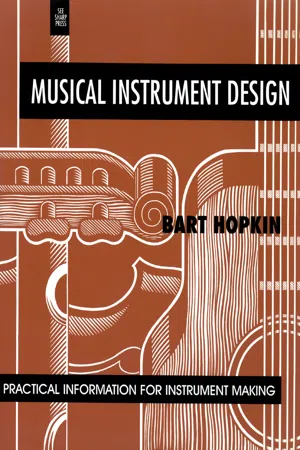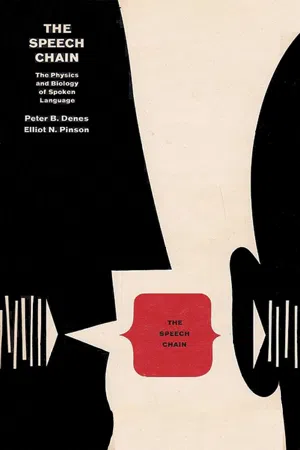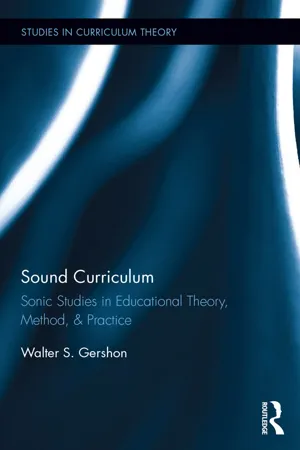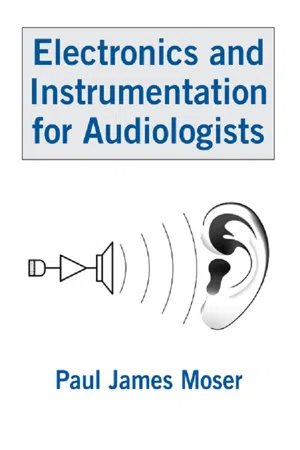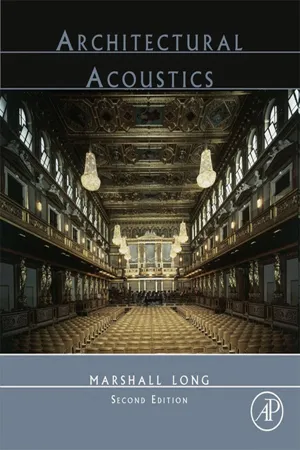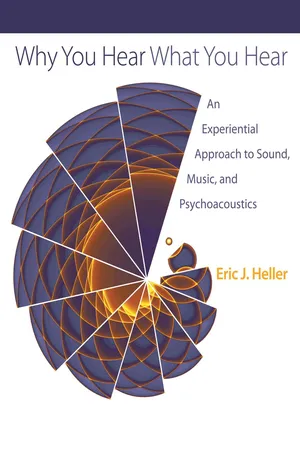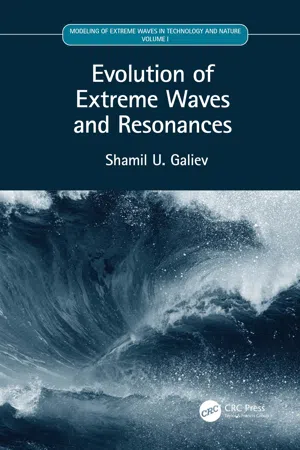Physics
Resonance in Sound Waves
Resonance in sound waves occurs when an external force matches the natural frequency of an object, causing it to vibrate with increased amplitude. This phenomenon is responsible for the production of music from instruments and the amplification of sound in acoustic systems. Understanding resonance is crucial in designing musical instruments and optimizing the performance of sound systems.
Written by Perlego with AI-assistance
Related key terms
Related key terms
1 of 4
Related key terms
1 of 3
9 Key excerpts on "Resonance in Sound Waves"
- eBook - ePub
Musical Instrument Design
Practical Information for Instrument Making
- Bart Hopkin(Author)
- 1996(Publication Date)
- See Sharp Press(Publisher)
standing waves. Standing waves are the steady-state vibrations that arise as a result of traveling waves reflecting back and forth in a string, air column, or other medium of finite dimensions. The interacting wave fronts reinforce or cancel one another to varying degrees all along the medium at each instant to create the standing wave form. It is not intuitively obvious, but the cumulative effects of the multiple reflections can account for all the complexity of the vibration patterns we see in musical instruments, including the presence of multiple frequencies (fundamentals and overtones) in the vibrating object.RESONANCE
Most natural vibrating systems show a preference for certain frequencies and not others. These natural frequencies are the frequencies at which the system will oscillate if given some sort of initial impulse and then left to vibrate on its own, as, for example, a guitar string will vibrate at a certain frequency each time it is plucked. Resonance is a function of this property. To illustrate, consider a tube that has one stopped end and one open end. The air in that tube has a springy quality: if it is momentarily compressed into the tube by some inward movement at the open end, increased pressure within will cause it to surge back out; in doing so it overshoots slightly, creating a relative vacuum that pulls it back in again. As this continues an oscillation of the air results just as if one had compressed and then released a coil spring.Now let's add to this system a driver — something that will repeatedly force air in and out of the open end of the tube, driving the enclosed air at some specific frequency. As an example, we'll use a piece of wood mounted so as to act as a marimba bar. Marimba bars flex up and down at the center when struck. If one is placed over the opening of a tube a short distance away, it has the effect of pushing small amounts of air in and out as it vibrates. Like most vibrating systems, the bar has a natural frequency at which it "wants" to vibrate, and so does the air column below. - eBook - ePub
The Speech Chain
The Physics And Biology Of Spoken Language
- Dr. Peter B. Denes, Dr. Elliot N. Pinson(Authors)
- 2016(Publication Date)
- Hauraki Publishing(Publisher)
When a sound wave reaches a volume of air enclosed in a container, an increase in the sound pressure compresses the air in the container. The “springiness” of the air inside the container tends to push the compressed air out again. If the rarefaction of the sound wave reaches the container at the same time the compressed air is being pushed out, the pressure of the sound wave and the pressure of the compressed air will add together and the air particles will move with increased amplitude. If the rate of arrival of the sound wave’s compressions and rarefactions (the rate being equal to the sound wave’s frequency of vibration) corresponds to a natural frequency of the enclosed air, we get increased movement or resonance. When we fill a bottle with water, we can actually hear it filling up. Resonance explains this: the splashing water generates sounds of many different frequencies, but the resonance of the air column above the water level emphasizes only those frequencies in the sound that are near its own natural frequency. As the bottle fills up, the size of the air column decreases (this increases the column’s resonant frequency), and higher frequency components of the “splashing” are emphasized. We know from experience that, when the pitch of the sound from the bottle is high enough, little air is left in the bottle and it is time to turn off the tap. The simple spring-mass combination has only one resonant frequency; columns of air have many different resonant frequencies. We will consider only the resonances of tubes whose cross-sectional dimensions are small compared to the wavelengths of the sounds applied to them. The vocal tract is just this sort of tube for the frequencies of primary interest in speech. A tube with uniform cross-sectional area throughout its length has regularly spaced resonant frequencies. The values of these resonant frequencies depend on the length of the tube. Consider a tube closed at one end and open at the other - eBook - ePub
Sound Curriculum
Sonic Studies in Educational Theory, Method, & Practice
- Walter S. Gershon(Author)
- 2017(Publication Date)
- Routledge(Publisher)
Resonance is produced by the oscillation of vibration, the peaks and valleys of something in and out of phase with itself and its surrounding nested layers of ecology. According to this understanding of resonance, everything has an iterative and recursive relationship at some level to itself and things not-itself. Rephrased slightly, everything resonates with itself and other kinds of things in ways that, while not predictive, are usually patterned—patterns that are in turn repeated so that they might be recognizable in kind. In this way, resonances can help identify possibilities of pattern while avoiding deterministic assumptions of them. Resonance therefore simultaneously denotes a particular kind of internal relations and the relationship between internal and external relations. Musically speaking, resonances are often presented in relation to the constructions of consonance and dissonance. Rather than walk down this road of how a sound relationship is defined as consonant or resonant, particularly as is often done utilizing Western art music 3 and its relationship to pure harmonies first ascribed by the church in the Middle Ages, I wish here to note that consonance and dissonance are sociocultural constructions. What is dissonant in one set of musical understandings can be consonant in another, the way a flat seventh can be dissonant in Western art music and consonant in the blues and many forms of jazz for example. To push at this point further, even jazz, with its similarly limited set of 12 possible tones, as compared to the so-called “microtones” of Carnatic (South Indian) or musqi-e assil (Iranian) “classical” music for example, often has tones that one is to play or not play in order to be consonant or dissonant with a given chord structure - eBook - ePub
The Working Voice
Vocal Health and Effective Communication
- Stephanie Martin, Olivia Darnley(Authors)
- 2024(Publication Date)
- Routledge(Publisher)
6 Resonance
DOI: 10.4324/9781003361114-7Introduction
Resonance plays a crucial role for professional voice users, enabling effortless message delivery and amplification while minimising vocal strain and fatigue. Vocal resonance is essentially the sound of the note, or ‘laryngeal buzz’, augmented and modified by the shape and size of your distinctive resonating cavities, the throat, mouth and nasal passages. These cavities determine the specific qualities and nuances of your tone, timbre and the richness of your voice.Very simply put, the intensity, or quality, of the sound you hear when you speak or sing is caused by the reverberation of sound waves from your vibrating vocal folds, which are enhanced by the air-filled resonators through which it passes. There are six main resonating areas in the body – the larynx, the pharynx, the oral cavity, the nasal cavity, the upper skull cavity and the chest – which modify and enhance the sound.In this chapter, we will look in detail at how to find more resonance and utilise the natural resonator available to you: your body and, specifically, your vocal tract.What Is It, Exactly?
The resonatory system modifies and amplifies the fundamental note and consists of:- – The chest.
- – The pharyngeal, oral and nasal cavities.
The resonators above the larynx can alter in size, shape and tension through the movement of the base of the tongue and the soft palate. In addition, further modification can occur through contraction of the pharyngeal and extrinsic laryngeal muscles.Although the larynx is obviously the primary contributor to the production of voice, without the acoustic influence of the resonators the voice would sound very thin indeed. Most of the quality and loudness characteristics associated with the voice are the result of the resonators. In the same way that the weak vibrations of the strings of a musical instrument are altered by the resonating body of the instrument, so the tone that is produced at the level of the larynx, the laryngeal buzz, is altered by the resonators. The airway above the larynx acts like an acoustic filter, which can suppress or maximise some sounds as they pass through. Alterations can also occur in the configuration of the vocal tract by varying tongue positions, raising or lowering the soft palate, and as an effect of the degree of relaxation or tension present. - eBook - ePub
- (Author)
- 2013(Publication Date)
- Psychology Press(Publisher)
Figure 13.26 , has a resonance frequency, although the resonance frequency changes as the stiffness varies.Acoustical Vibration
In the previous sections, you studied the vibrations and resonances of mechanical systems and the resonances of sound waves in pipes. There are also acoustical systems that vibrate much like mechanical systems but behave differently from pipes containing standing waves. A simple example of such a system is a Helmholtz resonator , a container with a neck at the opening.A jug is an example of a Helmholtz resonator. If you blow across the opening, you can make a very deep sound—much deeper (lower frequency and longer wavelength) than could be produced by a narrow pipe of a similar length. If you place your mouth tightly over the mouth of an empty (air-filled) jug and blow into it, you will find that, as air passes into the jug, your mouth and lungs must exert an ever-increasing pressure to push more air into the jug. This is like pushing against the force of a spring. Also, since there is air in the neck of the jug, it must move as air flows into and out of the jug.If the jug resonates, then air in the neck moves back and forth, like a mass on a spring. Also, the air within the volume of the jug responds like a spring by pushing back with increasing or decreasing pressure onFigure 13.29 Helmholtz resonator.the incoming air. Figure 13.29 shows that the resonator has a mass and stiffness, just like a mass on a spring. To complete the analogy between the two systems, Figure 13.30 shows that a fine wire screen can be used to resist the motion of the air in the neck, thus introducing a resistance.Acoustic Impedance
Acoustic impedanceZAdefines the relationship between sound pressure p and the volume velocity U measured at a particular surface. The volume velocity - eBook - ePub
Sound Studio
Audio techniques for Radio, Television, Film and Recording
- Alec Nisbett(Author)
- 2003(Publication Date)
- Routledge(Publisher)
Of greater practical importance is diffraction around an object in the path of a wave. If the wavelength is long compared with the width of the object, the wave is virtually undisturbed: it is as though the wave does not ‘see’ the object (but to reach the back of the object it has to travel further than if it could go right through it). If the obstruction is wider than the wave is long, it casts a shadow.Energy, intensity and resonance
There are several more concepts that we need before going on to consider the mechanics of music.First, the energy of a sound source. This depends on the amplitude of vibration: the broader the swing, the more power (energy output per second) it can produce. The sound intensity at any point is then measured as the acoustic energy passing through unit area per second. But to convert the energy of a sound source into acoustic energy in the air, we have to ensure that the sound source is properly coupled to the air, so that its own vibrations are causing the air to vibrate with it. Objects that are small (or slender) compared with the wavelength in air associated with their frequency of vibration (e.g. tuning forks and violin strings) are able to slice through the air without giving up much of their energy to it: the air simply slips around the sides of the prong or the string.If a tuning fork is struck and then suspended loosely it goes on vibrating quietly for a long time. If, however, its foot is placed on a panel of wood, the panel is forced into vibration in sympathy and can transmit vibration to the air. The amplitude of vibration of the tuning fork then goes down as its energy is lost (indirectly) to the air.[2.10 ] Sound intensityThis is the energy passing through unit area per second. For a spherical wave (i.e. a wave from a point source) the intensity dies away very rapidly at first. The power of the sound source S is the total energy radiated in all directions.[2.11 ] Tuning fork1 and 2, Each fork vibrates at a specific natural frequency, but held in free air radiates little sound. 3, laced against a wooden panel, the vibrations of the tuning fork are coupled to the air more efficiently and the fork is heard clearly. 4, laced on a box having a cavity with a natural resonance of the same frequency as the tuning fork, the sound radiates powerfully. - eBook - ePub
- Marshall Long(Author)
- 2014(Publication Date)
- Academic Press(Publisher)
6Wave Acoustics
Abstract
Chapter 6 includes a discussion of the factors that separate acoustical phenomena that can be modeled based on energy from those that must take into account the wave behavior of sound. It begins with an analysis of simple oscillators and their resonances (for example air spring oscillators) and moves on to Helmholtz resonators, deriving the wave equation in one and three dimensions, and characterizing simple point sources and various configurations of line source. It details coherent planar sources (examples include the piston in a baffle) and discusses the construction of loudspeakers (e.g., cone and horn) and their modeling.Keywords
wave equation ; resonance ; Helmholtz resonator ; monopole/dipole ; doublet ; noise cancellation ; arrays ; line sources ; comb filter ; loudspeaker ; constant directivity hornMuch of architectural acoustics can be addressed without consideration of the wave nature of sound. For example, environmental acoustics and the transmission of outdoor sound, for the most part, can be visualized and modeled as a flow of energy from point to point, although many effects, such as ground and barrier attenuation, are frequency dependent. Nevertheless, for many critical aspects of acoustics, knowledge of wave phenomena is essential. Wave acoustics takes into account fundamental properties that are wavelength and phase dependent, including the scaling of interactions to wavelength, the phenomenon of resonance, and the combination of amplitudes based not only on energy but also on phase.6.1 .ResonanceSimple Oscillators
Many mechanical systems have forces that restore a body to its equilibrium position after it has been displaced. Examples include a spring mass, a child’s swing, a plucked string, and the floor of a building. When such a system is pulled away from its rest position, it will move back toward equilibrium, transition through it, and go beyond, only to return again and repeat the process. All linear oscillators are constrained such that, once displaced, they return to their initial position. The movement repeats at regular intervals that have a characteristic duration and thus a characteristic frequency, called the natural frequency or resonant frequency of the system. - eBook - ePub
Why You Hear What You Hear
An Experiential Approach to Sound, Music, and Psychoacoustics
- Eric J. Heller(Author)
- 2012(Publication Date)
- Princeton University Press(Publisher)
section 16.3 ).Figure 10.10 The on-resonance tug-of-war between sound confinement and internal friction results in this resonance advantage curve for the release of sound. For a system operating on resonance, sound output power first increases, then reaches a maximum, and then decreases as it is made easier for sound to escape. The maximum sound radiation occurs when the damping due to the sound radiation equals the internal friction damping.A Physical Model
A simple physical model illustrates the competing factors of resonance and friction. Suppose we drive a damped spring-mass oscillator from the wall side (the point of attachment of the spring to the wall). Resonance at the oscillator frequency is an impedance maximum, because if we control the velocity (the denominator in Z = F /V ) of the drive, large forces (the numerator in Z ) will be required to maintain the velocity on resonance (see also section 10.6 ). Driving the mass and spring on resonance also corresponds to maximum power supplied by the drive, determined by the friction. The power simply heats the system. The less the damping, the higher the power reached on resonance, as before.Now suppose the oscillating mass is connected by a (massless) lever to a loudspeaker—a large massless stretched membrane embedded in air (figure 10.11 ). The mass now rocks the lever and shakes the membrane, launching sound; the membrane is an efficient loudspeaker (we suppose it is baffled; not shown) but also another source of damping to the mass-spring system. By changing the pivot point, we can shake the membrane by a little or a lot for a given excursion of the mass. Here’s the question: what is the maximum sound power we can get out of this arrangement, given that we shake the wall with a given sinusoidal velocity υ (t ) = υ 0 sin(2π ft - eBook - ePub
- Shamil U. Galiev(Author)
- 2020(Publication Date)
- CRC Press(Publisher)
4 Extreme Resonant Waves A Quadratic Nonlinear TheoryThe main researches in the subsequent sections of this part will be paid to forced oscillations, since for them there are experimental data allowing to estimate the accuracy of the theory. The most important step in understanding wave processes in resonators from a physical point of view is the definition of its eigenfunctions. These functions are determined by the corresponding wave equation. It is remarkable that the wave equations describing various physical media are similar (see Chapters 1 and 2 ). Moreover, in the linear approximation, they have similar eigenfunctions being excited in many musical instruments. From such positions, as Frank Wilczek [28] notes, a hydrogen atom can be viewed as a musical instrument like a gong. But until now, this meant fluctuations having a small amplitude, while we mean nonlinear eigenfunctions [29,30]. Indeed, our solutions presented in Chapter 3 represent the traveling waves J and j as nonlinear eigenfunctions (see Eq. (3.89)).The main researches in the subsequent sections of this part will be paid to forced oscillations, since for them there are experimental data allowing to estimate the accuracy of the theory. The most important step in understanding wave processes in resonators from a physical point of view is the definition of its eigenfunctions. These functions are determined by the corresponding wave equation. It is remarkable that the wave equations describing various physical media are similar (see Chapters 1 and 2 ). Moreover, in the linear approximation, they have similar eigenfunctions being excited in many musical instruments. From such positions, as Frank Wilczek [28] notes, a hydrogen atom can be viewed as a musical instrument like a gong. But until now, this meant fluctuations having a small amplitude, while we mean nonlinear eigenfunctions [29,30]. Indeed, our solutions presented in Chapter 3
Index pages curate the most relevant extracts from our library of academic textbooks. They’ve been created using an in-house natural language model (NLM), each adding context and meaning to key research topics.
Explore more topic indexes
Explore more topic indexes
1 of 6
Explore more topic indexes
1 of 4
